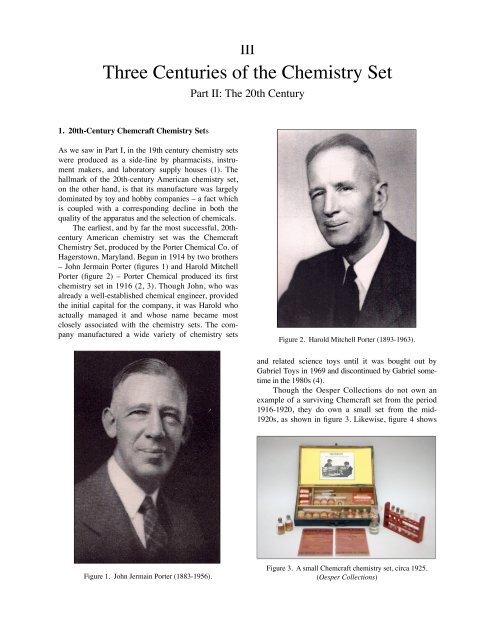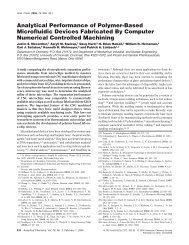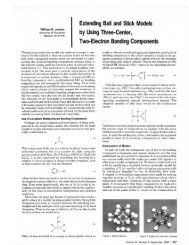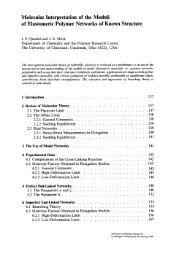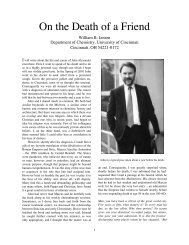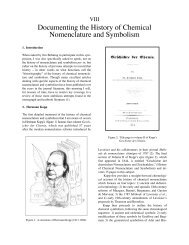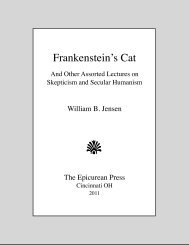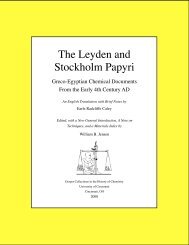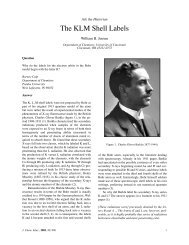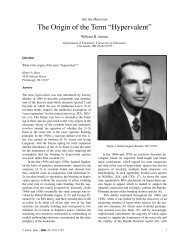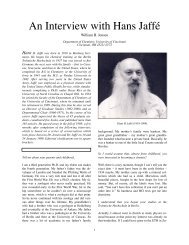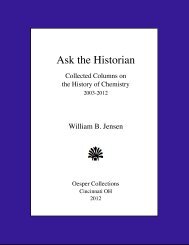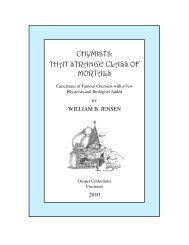03. Chemistry Sets 2'.pdf
03. Chemistry Sets 2'.pdf
03. Chemistry Sets 2'.pdf
Create successful ePaper yourself
Turn your PDF publications into a flip-book with our unique Google optimized e-Paper software.
III<br />
Three Centuries of the <strong>Chemistry</strong> Set<br />
Part II: The 20th Century<br />
1. 20th-Century Chemcraft <strong>Chemistry</strong> <strong>Sets</strong><br />
As we saw in Part I, in the 19th century chemistry sets<br />
were produced as a side-line by pharmacists, instrument<br />
makers, and laboratory supply houses (1). The<br />
hallmark of the 20th-century American chemistry set,<br />
on the other hand, is that its manufacture was largely<br />
dominated by toy and hobby companies – a fact which<br />
is coupled with a corresponding decline in both the<br />
quality of the apparatus and the selection of chemicals.<br />
The earliest, and by far the most successful, 20thcentury<br />
American chemistry set was the Chemcraft<br />
<strong>Chemistry</strong> Set, produced by the Porter Chemical Co. of<br />
Hagerstown, Maryland. Begun in 1914 by two brothers<br />
– John Jermain Porter (figures 1) and Harold Mitchell<br />
Porter (figure 2) – Porter Chemical produced its first<br />
chemistry set in 1916 (2, 3). Though John, who was<br />
already a well-established chemical engineer, provided<br />
the initial capital for the company, it was Harold who<br />
actually managed it and whose name became most<br />
closely associated with the chemistry sets. The company<br />
manufactured a wide variety of chemistry sets<br />
Figure 2. Harold Mitchell Porter (1893-1963).<br />
and related science toys until it was bought out by<br />
Gabriel Toys in 1969 and discontinued by Gabriel sometime<br />
in the 1980s (4).<br />
Though the Oesper Collections do not own an<br />
example of a surviving Chemcraft set from the period<br />
1916-1920, they do own a small set from the mid-<br />
1920s, as shown in figure 3. Likewise, figure 4 shows<br />
Figure 1. John Jermain Porter (1883-1956).<br />
Figure 3. A small Chemcraft chemistry set, circa 1925.<br />
(Oesper Collections)
WILLIAM B. JENSEN<br />
Figure 4. Fragments of a Chemcraft chemistry set, c. 1950s.<br />
(Oesper Collections)<br />
some fragments of a Chemcraft set from the late 1950s,<br />
also from our collections, and figure 5 shows a period<br />
photograph of the actual assembly line in Hagerstown<br />
from roughly the same period.<br />
Figure 5. The assembly line at the Chemcraft factory<br />
in the late 1950s.<br />
Figure 7. The interior of the Chemcraft set shown in figure 6.<br />
(Oesper Collections)<br />
Figures 6 and 7 show the exterior and interior of a<br />
complete Chemcraft set from our collections dating<br />
from the mid 1960s and which was obviously manufactured<br />
sometime after the Porter Chemical Company’s<br />
1961 merger with the Lionel Train Company of<br />
New York. Note the emphasis on friendly uses of radioactivity<br />
as indicated by the booklet inside the lefthand<br />
panel and by the black, plastic spinthariscope<br />
standing next to the alcohol lamp in front of the center<br />
panel. This same emphasis is also apparent in the<br />
earlier advertisement from the 1950s in figure 8, showing<br />
a boy peering into a spinthariscope composed of a<br />
lens, a small radioactive source, and a zinc sulfide<br />
screen. This is obviously intended to be stored in the<br />
circular opening at the top of the center panel labelled<br />
“Atomic Energy” and is apparently connected with the<br />
packet in front of the boy labelled “Radioactive<br />
Screen.” Can you imagine the paranoid parents of today<br />
allowing their children near anything radioactive –<br />
however benign? After all, we don’t live in the age of<br />
Figure 6. Exterior of a Lionel-Porter Chemcraft chemistry<br />
set, c. 1962. (Oesper Collections)<br />
Figure 8. A Chemcraft advertisement from the period 1945-<br />
1955 showing a boy peering into a spinthariscope in order to<br />
observe the scintillations produced by the impact of the radioactive<br />
emissions on a ZnS screen.<br />
2
THREE CENTURIES OF THE CHEMISTRY SET: PART II<br />
the background and the chemistry set in the foreground<br />
are out of phase by almost a decade and, to add insult<br />
to anachronism, the few bottles resting on the top of<br />
the Chemcraft chemistry set are actually from a Gilbert<br />
rather than a Chemcraft set.<br />
2. The <strong>Chemistry</strong> Club Rage<br />
Figure 9. A typical Chemcraft chemistry set from the mid<br />
1970s. (Oesper Collections)<br />
magnetic imaging rather than nuclear magnetic imaging<br />
for nothing.<br />
Figure 9 shows a typical Chemcraft set from our<br />
collections dating from the mid-1970s, after the company<br />
was purchased by Gabriel Toys. Note the experiment<br />
by numbers approach on the plastic snap-top bottles<br />
and the baking soda-vinegar rocket on the far left –<br />
a far cry from the pyromania of the Kingsley Primus<br />
Magic Set mentioned in Part I.<br />
Finally, figure 10 shows a recent and seriously<br />
flawed attempt to cash in on chemistry-set nostalgia in<br />
the form of a Madison Avenue reconstruction of a<br />
circa-1950s amateur chemist and his trusty Chemcraft<br />
<strong>Chemistry</strong> Set. Unhappily the date on the calendar in<br />
In addition to its chemistry sets, the Porter Chemical<br />
Co. also attempted to cash in on the <strong>Chemistry</strong> Club<br />
rage which swept through American schools after<br />
World War I, largely as a result of an intensive propaganda<br />
campaign conducted by the Chemical Foundation<br />
in an attempt to make Americans more aware of<br />
the economic importance of chemistry (5). This lesson<br />
had been brought home by the War itself, which had<br />
caught Americans off guard and revealed their almost<br />
total dependence on Germany for the importation of<br />
dyes, pharmaceuticals, and other fine organic chemicals.<br />
With the purchase of a Chemcraft Set you could<br />
write to the company and become an official Chemcraft<br />
Chemist and member of the national Chemcraft<br />
Science Club (figure 11). Even more important, as the<br />
company repeatedly emphasized in its advertising, you<br />
could join with your friends and form your own local<br />
chapter.<br />
Figure 11. A membership card for the Chemcraft Science Club.<br />
Figure 10. A modern retro-ad featuring a Chemcraft<br />
chemistry set<br />
The company also published a magazine for the<br />
members of the Chemcraft Science Club called, quite<br />
naturally, The Chemcraft Chemist. This was largely a<br />
catalog of additional chemicals and equipment you<br />
could purchase to supplement your chemistry set –<br />
much of which, unlike the scaled-down toy versions in<br />
the set itself, corresponded to real professional apparatus.<br />
However, there were also short articles on recent<br />
advances in chemistry, a copy of the by-laws for the<br />
chemistry club, and occasional short stories by the<br />
members – mostly of the Tom Swift - Horatio Alger<br />
variety. Thus the issue from 1934, shown in figure 12,<br />
3
WILLIAM B. JENSEN<br />
Figure 14. Amateur plans for a home laboratory, c. 1937.<br />
Figure 12. Cover of the issue 1 of the Chemcraft Chemist for 1934.<br />
contained articles on the chemistry of cloth and nitrogen<br />
and a story by Milton Burdick, reprinted from the<br />
1921 issue, entitled “The Boy Chemist Life Saver.”<br />
One day the hero of the story happens to be walking<br />
down by the local railroad yard when he see a<br />
crowd gathered around an open boxcar. When he asks<br />
what is going on, he is told that two men were unloading<br />
tanks of chlorine gas when one of the tanks tipped<br />
over and the valve broke off, releasing chlorine into the<br />
car. Both men were now laying unconscious on the<br />
floor of the car and the crowd was unable to reach<br />
them because of the toxic fumes. However, the boy<br />
chemist life saver remembers from experiment 20 of<br />
his Chemcraft <strong>Chemistry</strong> Set that hypo or sodium<br />
thiosulfate absorbs chlorine. He dashes across the<br />
street to the drug store, which also happens to sell photographic<br />
chemicals, and yells, “Quick! A bag of<br />
hypo.” He moistens this, claps it over his nose and<br />
Figure 13. A complete home laboratory bench for the serious<br />
amateur sold by Chemcraft for only $32.85, c. 1937. Figure 15. Amateur plans for a home laboratory, c. 1937.<br />
4
THREE CENTURIES OF THE CHEMISTRY SET: PART II<br />
mouth, and then leaps into the boxcar, where he succeeds<br />
in dragging both men to safety. And, as a reward<br />
for his heroism, the railroad company gives him –<br />
surprise, surprise! – a No. 25 Deluxe Chemcraft Set.<br />
Chemcraft also offered various handbooks for its<br />
club members – again roughly 80% catalog and 20%<br />
information. Not only could you buy additional equipment<br />
and chemicals, you could also buy an entire laboratory<br />
(figure 13) complete with lab bench and sink,<br />
the latter having a rubber hose attached for drainage<br />
into a conveniently-placed waste crock. Or you could<br />
trade blueprints for building your own laboratory<br />
bench with fellow Chemcraft chemists throughout the<br />
country, as shown in the examples in figures 14 and 15,<br />
taken from the 1937 booklet Chemcraft Glassblowing<br />
and the Construction of Laboratory Apparatus.<br />
3. Gender Issues<br />
It has probably not escaped the attention of a sizable<br />
portion of the audience that there is a rather blatant<br />
sexual bias to all this advertising. You are admonished<br />
to become not just an “Amateur Chemist” but a “Boy<br />
Chemist.” Books of popular chemistry experiments<br />
(figure 16) show parents contentedly watching their<br />
sons, but not their daughters, push back the frontiers of<br />
chemical knowledge in the middle of their very own<br />
living rooms. And what was conveyed implicitly in the<br />
cover illustration often appeared explicitly in the title<br />
(figure 17). However, if there was no Chemcraft for<br />
girls, there was at least – as advertised in figure 18 –<br />
Sachetcraft!<br />
Figure 17. <strong>Chemistry</strong> for boys but not girls, c, 1940.<br />
Of course, our trouble with all of this is just that –<br />
our trouble – and comes from projecting our current set<br />
of mores back to a time when they do not apply. You<br />
cannot – or rather you should not – rewrite or suppress<br />
history to suit your current biases. Instead you should<br />
try to understand how it is different from the present<br />
and why. The young women in the audience should<br />
come to understand just how recent are many of the<br />
changes in our society which affect them, and when<br />
they encounter a woman scientist in her late 60s and<br />
70s, appreciate the enormous societal barrier which<br />
Figure 16. A popular book of chemistry experiments showing<br />
parents watching their sons perform chemical experiments<br />
in the living room, c. 1932. Figure 18. Chemcraft’s alternative for girls - Sachetcraft, c. 1928.<br />
5
WILLIAM B. JENSEN<br />
Figure 19. Albert Carlton Gilbert (1884-1961).<br />
this woman had to overcome just to conceive of the<br />
idea of a career in science in the first place.<br />
4. 20th-Century Gilbert <strong>Chemistry</strong> <strong>Sets</strong><br />
Figure 21. Interior of the Gilbert set shown in figure 20.<br />
chemicals came in either cylindrical wooden containers<br />
or corked glass vials.<br />
Figure 22 shows a small Gilbert set in a cardboard<br />
box from our collections at Cincinnati which dates<br />
from the late 1930s or early 1940s. Since Chemcraft<br />
The second great line of 20th-century American chemistry<br />
sets was started by Albert Carlton Gilbert (figure<br />
19). A graduate of Yale, Gilbert was a former Olympic<br />
Pole Vaulting champion whose hobby was magic. He<br />
began his manufacturing career in 1909 by producing<br />
Mysto Magic <strong>Sets</strong>. In 1913 he added the famous “Erector<br />
Construction Kits” to his growing line of hobby<br />
toys, and in 1917 also added a line of chemistry sets<br />
with a manual edited by Treat B. Johnson, his former<br />
chemistry teacher at Yale (6, 7). Like Chemcraft, Gilbert<br />
was bought out by Gabriel Toys in 1967 and its<br />
line of chemistry sets was discontinued (4).<br />
Figures 20 and 21 show a very early Gilbert Set<br />
dating from the early 1920s. The heavy wooden box<br />
with brass handles is unusual for an American chemistry<br />
set. As with the early Chemcraft sets, the solid<br />
Figure 22. A small Gilbert <strong>Chemistry</strong> Set, c. 1938-1942.<br />
(Oesper Collections)<br />
Figure 20. The exterior of a Gilbert <strong>Chemistry</strong> Set, c. 1920.<br />
had used red as the signature color for it sets, Gilbert<br />
had, by this time, switched to blue for its signature<br />
color and had replaced the wooden containers with<br />
brown glass bottles. A similar switch from wood cylinders<br />
to glass bottles occurs at about the same time for<br />
the Chemcraft sets.<br />
Figures 23 and 24 show the exterior and interior<br />
of a typical Gilbert set from the late 1950s or early<br />
1960s – again from our collections at Cincinnati. By<br />
this time the wooden and cardboard boxes had been<br />
replaced by foldout metal boxes with the advertising<br />
stamped directly on the front, and the brown glass bot-<br />
6
THREE CENTURIES OF THE CHEMISTRY SET: PART II<br />
Figure 23. The exterior of a typical Gilbert chemistry set<br />
from the late 1950s or early 1960s.<br />
(Oesper Collections)<br />
tles had been replaced by smaller square, clear-glass<br />
bottles. The molecular model kit shown in the upper<br />
corner of the right-hand panel really consisted of toy<br />
plastic beads which automatically placed all bonds in<br />
the same plane – i.e. carbon was square-planar – thus<br />
defeating the entire purpose of molecular models in the<br />
first place. In addition, 90% of the examples given in<br />
the booklet which went with the model kit consisted of<br />
models of nonexistent molecules for what were, in<br />
reality, nonmolecular solids – i.e. sodium chloride is<br />
represented as a diatomic molecule, sodium carbonate<br />
as a discrete hexatomic molecule, etc. - again all of<br />
them with a planar geometry.<br />
Figure 25. The Gilbert “Atomic Energy Lab” set, c. 1959.<br />
(Oesper Collections)<br />
From these examples it is apparent that Chemcraft<br />
and Gilbert closely monitored one another’s products<br />
and generally imitated one another. This is further illustrated<br />
by the fad in the late 1940s and 1950s concerning<br />
atomic energy and radioactivity. As we saw<br />
earlier, Chemcraft sets from this period contained<br />
pamphlets on this subject, as well as a small metal or<br />
plastic spinthariscope. Gilbert, however, went one better<br />
and actually offered an entire “Atomic Energy<br />
Laboratory” (figure 25) containing not only a spin-<br />
Figure 24. Interior of the Gilbert set in figure 23.<br />
(Oesper Collections)<br />
Figure 26. The Gilbert cloud chamber in operation.<br />
7
WILLIAM B. JENSEN<br />
thariscope, but a crude Geiger counter and the means<br />
to assemble a complete cloud chamber, which is shown<br />
in operation in the advertisement in figure 26.<br />
Though both Chemcraft and Gilbert produced a<br />
wide variety of science and hobby toys, the chemistry<br />
set remained the centerpiece of the Chemcraft line<br />
while the Erector Set remained the centerpiece of the<br />
Gilbert line. This difference in emphasis was reflected<br />
in the fact that, while the Chemcraft Science Clubs and<br />
the Chemcraft Chemist magazine focused on chemistry,<br />
the Gilbert equivalent – the Gilbert Institute of Engineering<br />
– focused on engineering and mechanics<br />
instead. Indeed, it even granted “degrees” to boys who<br />
had successfully completed a prescribed number of<br />
projects with their Erector sets, radio sets, etc.<br />
During the 1920s Gilbert also sponsored a private<br />
“demonstration” train car which toured cities along the<br />
eastern sea board. Besides a complete display of Gilbert’s<br />
educational toys, the car featured a live magician<br />
doing magic tricks with Mysto magic sets, an engineer<br />
explaining the construction and operation of moving<br />
models built with the Erector set, a person doing chemistry<br />
experiments with Gilbert chemistry sets, and a<br />
radio operator who received periodic broadcasts on his<br />
Gilbert crystal radio set supposedly beamed directly<br />
from Gilbert’s headquarters in New Haven, though in<br />
reality they were being broadcasted from a closet located<br />
inside the car itself.<br />
Figure 28. A large Skilcraft <strong>Chemistry</strong> Set, c. 1975.<br />
(Oesper Collections)<br />
But perhaps the biggest competitor for Chemcraft<br />
and Gilbert, prior to their being swallowed by Gabriel<br />
Toys, was the Chicago-based Skilcraft <strong>Chemistry</strong> Set,<br />
which began production in 1963 (4). Figure 28 shows<br />
the interior of a typical example in our collections<br />
dating from the early 1970s. Note the total lack of any<br />
resemblance between the plastic containers and the<br />
equipment in this set and the corresponding items<br />
found in an actual chemical laboratory.<br />
Figure 29 shows a Scottish-made chemistry set<br />
from the early 1980s manufactured by Thomas Salter<br />
Toys and Sports – again from our collections. This is,<br />
without a doubt, the best chemistry set I have seen in<br />
recent years and contains chemicals, such as potassium<br />
chromate, potassium permanganate, and zinc powder,<br />
that would no longer be allowed in American sets, as<br />
well as a much larger selection of apparatus – albeit<br />
still of the undersized toy variety.<br />
And last, but not least, figure 30 shows a recent<br />
chemistry set purchased for our collections in downtown<br />
Cincinnati during the Xmas season of 1989 for<br />
Figure 27. The Gilbert Train Car.<br />
5. Other 20th-Century <strong>Chemistry</strong> <strong>Sets</strong><br />
There were, of course, other American companies besides<br />
Chemcraft and Gilbert that produced chemistry<br />
sets, though I have come upon few surviving examples.<br />
Thus the Lionel company, of electric train fame, produced<br />
a chemistry set in the 1940s and 1950s, but discontinued<br />
production after its acquisition of Chemcraft<br />
in 1961 (4). I have also come across stray bottles from<br />
the same period from a so-called “Handy Andy <strong>Chemistry</strong><br />
Set.”<br />
Figure 29. A Salter chemistry set from the 1980s<br />
(Oesper Collections)<br />
8
THREE CENTURIES OF THE CHEMISTRY SET: PART II<br />
6. The Decline of the <strong>Chemistry</strong> Set<br />
Figure 30. A recent chemistry set, c. 1989.<br />
(Oesper Collections)<br />
$39.00. Note that there are very few chemicals, all of<br />
them in small plastic vials. Also note the plastic balance,<br />
the plastic test-tube racks, and the plastic safety<br />
glasses on the far right, whose effectiveness in an actual<br />
accident is dubious to say the least. In short, this is<br />
an expensive and pitiful ghost of its 19th century<br />
predecessors.<br />
In 1970 50% of all science toys sold in the United<br />
States were chemistry sets (4). In 1990 we could find<br />
only one chemistry set for sale at the peak of the annual<br />
Christmas toy saturnalia. Why? One obvious reason<br />
is the growing obsession with so-called safety in<br />
our litigation-mad society, which makes the manufacture<br />
of chemistry sets a risky business, and which<br />
makes those that are produced increasingly boring.<br />
However, a more important reason may be found<br />
in the advertisement shown in figure 31 – namely a<br />
major change in the public’s image of what science is<br />
and how it is done, brought about by the advent of the<br />
home computer. More and more the public, not to mention<br />
many so-called chemical educators, are of the<br />
opinion that science can be done solely on a computer<br />
without actual experimentation, without any contact<br />
with real phenomena, without messy chemicals or<br />
stinks. As the ad says, “experiment on your own, without<br />
the worry of blowing up the house or dissolving<br />
yourself” – a parent’s dream, no doubt, but I ask you,<br />
would there have been any point to wanting a chemistry<br />
set as a kid if there hadn’t been the slim possibility<br />
of blowing up the house or dissolving yourself? <br />
This change also permeates the image of science<br />
presented in movies and on television and is best illustrated<br />
by the Walt Disney movies “The Absent Minded<br />
Professor” and “The Son of Flubber.” In the original<br />
movie versions which I saw as a kid, Fred McMurry<br />
creates his antigravity polymer using experimental<br />
chemistry – wonderful arrays of boiling flasks and distillation<br />
columns. In the recent television remake, on<br />
the other hand, flubber is created by a talking McIntosh<br />
Computer.<br />
7. Acknowledgements<br />
I've come to the end at last. This is the point in a normal<br />
seminar talk when the speaker shows a slide of his<br />
graduate students and thanks his funding agencies. I,<br />
alas, have only my mother to thank. And I do thank her<br />
for putting up with the stinks and bangs, the damaged<br />
sinks, and for not killing me on that January day in the<br />
middle of a freezing Wisconsin winter when we had to<br />
vacate the house because the family cat had broken a<br />
quart of formaldehyde in my basement lab (figure 32).<br />
8. References and Notes<br />
Figure 31. The “virtual” chemistry set of the future?<br />
1. First presented at the “Symposium on the History of<br />
the <strong>Chemistry</strong> Set,” held at the 11th Biennial Conference on<br />
Chemical Education, Georgia Institute of Technology, Atlanta,<br />
GA, 05-19 August 1990 and on many occasions since.<br />
9
WILLIAM B. JENSEN<br />
Figure 32. The author in his basement laboratory, c. 1963.<br />
The original talk used 53 slides. Consequently in producing a<br />
printed version I have had to drastically cut the number of<br />
illustrations and, in order to make the file size reasonable, I<br />
have also had to divide the talk into two parts – the first dealing<br />
with the chemistry set in the 18th and 19th centuries and<br />
the second dealing largely with 20th-century American<br />
chemistry sets. In preparing the written account I have also<br />
added relevant references which have appeared since 1990.<br />
2. W. D. Myles, R. F. Gould, Eds, American Chemists<br />
and Chemical Engineers, Vol. 2, Gould Books: Guilford, CT,<br />
1994, pp. 226-229.<br />
3. J. Tyler, The Chemcraft Story: The Legacy of Harold<br />
Porter, St. Johann Press: Haworth, NJ, 20<strong>03.</strong><br />
4. “<strong>Chemistry</strong> <strong>Sets</strong> Lead Science Toy Market,” Chem.<br />
Eng. News, 1970, 48(14 Dec.), 22-24.<br />
5. D. J. Rhees, “The Chemist’s War: The Impact of<br />
World War I on the American Chemical Profession,” Bull.<br />
Hist. Chem., 1992-1993, 13-14, 40-47.<br />
6. A. C. Gilbert, M. McClintock, The Man Who Lives<br />
in Paradise, Rinehardt: New York, NY, 1954.<br />
7. B. Watson, The Man Who Changed How Boys and<br />
Toys Were Made, Viking: New York, NY, 2002.<br />
10


